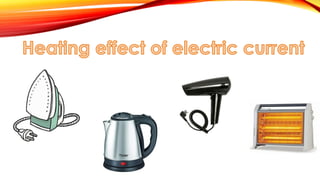Ohm's law states that the voltage across a conductor is directly proportional to the current flowing through it, provided all physical conditions and temperatures remain constant. Resistance is a measure of opposition to current flow and depends on the material, length, and cross-sectional area of the conductor. The heating effect of electric current is used in various appliances like electric bulbs, heaters, and irons where a conductor is heated by the passage of current. Electric power is defined as the rate at which electrical energy is transferred by a circuit and is measured in watts.

























































































